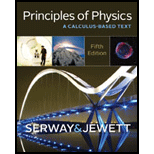
Concept explainers
(a)
Energy produced by the fission of
(a)
Answer to Problem 58P
Energy produced by the fission of
Explanation of Solution
Write the equation to find the number of nuclie in the given mass.
Here,
Write the equation to find the total energy produced.
Here,
Conclusion:
Substitute
Substitute
Therefore, the energy produced by the fission of
(b)
Energy produced by the deuterium –tritium fusion reaction.
(b)
Answer to Problem 58P
Energy produced by the deuterium –tritium fusion reaction is
Explanation of Solution
Write the equation to find the Energy produced by the deuterium –tritium fusion reaction.
Here,
Write the equation to find
Here,
Rewrite the expression for
Conclusion:
Substitute
Therefore, the energy produced by the deuterium –tritium fusion reaction is
(c)
Energy produced by the deuterium –tritium fusion reaction for
(c)
Answer to Problem 58P
Energy produced by the deuterium –tritium fusion reaction for
Explanation of Solution
Write the equation to find the energy produced by the deuterium –tritium fusion reaction for given mass of deuterium.
Here,
Write the equation to find the number of nuclie in the given mass.
Here,
Rewrite equation (I) by substituting the above relation for
Conclusion:
Substitute
Therefore, the energy produced by the deuterium –tritium fusion reaction for
(d)
Energy produced by the combustion of
(d)
Answer to Problem 58P
Energy produced by the combustion of
Explanation of Solution
Write the equation to find the energy produced by the deuterium –tritium fusion reaction for given mass of deuterium.
Here,
Write the equation to find the number of nuclie in the given mass.
Here,
Rewrite the equation for
Conclusion:
Substitute
Therefore, the energy produced by the combustion of
(e)
The pros and corns of energy production by fission, fusion, and combustion.
(e)
Explanation of Solution
To produce energy by combustion, coal is used. Coal is abundant form of fossil fuel and it is very cheap. The disadvantage is the high carbon emission and thereby acts as a major contributor in global warming. Energy production by nuclear fission cannot produce carbon and the working of reactor cannot cause any pollution. But the disposal of radioactive waste materials from the reactor is a very big challenge.
Nuclear fusion is better than fission since it does not produce radioactive by-products. But researches on nuclear fusion reactor are in developing stage only and it requires extreme high temperature for its working that cannot be achieved by man at present. Plutonium is a very risky material to handle in fission process.
Therefore, combustion is cheaper, but carbon emission is high, fission cannot cause global warming but produce radioactive bye products, and nuclear fusion cannot produce radioactive pollution but requires very large temperature that cannot be achieved in a laboratory at present.
Want to see more full solutions like this?
Chapter 30 Solutions
Principles of Physics
- The annual radiation dose from 14C in our bodies is 0.01 mSv/y. Each 14C decay emits a averaging 0.0750 MeV. Taking the fraction of 14C to be 1.31012N of normal 12C, and assuming the body is 13% carbon, estimate the fraction of the decay energy absorbed. (The rest escapes, exposing those close to you.)arrow_forward(a) Calculate the energy released in the neutron- Induced fission reaction n+235U92Kr+142Ba+2n , given m(92Kr) = 91.926269 u and m(142Ba)= 141.916361 u. (b) Confirm that the total number of nucleons and total charge are conserved in this reaction.arrow_forward(a) Calculate the energy released in the neutroninduced fission reaction n+239Pu96Sr+140Ba+4n, given m(96Sr)=95.921750u and m(140Ba)=139.910581u. (b) Confirm that the total number of nucleons and total charge are conserved in this reaction.arrow_forward
- Assume onefourth of the yield of a typical 320kT strategic bomb comes from fission reactions averaging 200 MeV and the remainder from fusion reactions averaging 20 MeV. (a) Calculate the number of fissions and the approximate mass of uranium and plutonium fissioned, taking the average atomic mass to be 238. (b) Find the number of fusions and calculate the approximate mass of fusion fuel, assuming an average total atomic mass of the two nuclei in each reaction to be 5. (c) Considering the masses found, does it seem reasonable that some missiles could carry 10 warheads? Discuss, noting that the nuclear fuel is only a part of the mass of a warhead.arrow_forward(a) How many 239Pu nuclei must fission to produce a 20.0kT yield, assuming 200 MeV per fission? (b) What is the mass of this much 239Pu?arrow_forward
 Principles of Physics: A Calculus-Based TextPhysicsISBN:9781133104261Author:Raymond A. Serway, John W. JewettPublisher:Cengage Learning
Principles of Physics: A Calculus-Based TextPhysicsISBN:9781133104261Author:Raymond A. Serway, John W. JewettPublisher:Cengage Learning Physics for Scientists and Engineers with Modern ...PhysicsISBN:9781337553292Author:Raymond A. Serway, John W. JewettPublisher:Cengage Learning
Physics for Scientists and Engineers with Modern ...PhysicsISBN:9781337553292Author:Raymond A. Serway, John W. JewettPublisher:Cengage Learning College PhysicsPhysicsISBN:9781285737027Author:Raymond A. Serway, Chris VuillePublisher:Cengage Learning
College PhysicsPhysicsISBN:9781285737027Author:Raymond A. Serway, Chris VuillePublisher:Cengage Learning College PhysicsPhysicsISBN:9781305952300Author:Raymond A. Serway, Chris VuillePublisher:Cengage Learning
College PhysicsPhysicsISBN:9781305952300Author:Raymond A. Serway, Chris VuillePublisher:Cengage Learning College PhysicsPhysicsISBN:9781938168000Author:Paul Peter Urone, Roger HinrichsPublisher:OpenStax College
College PhysicsPhysicsISBN:9781938168000Author:Paul Peter Urone, Roger HinrichsPublisher:OpenStax College Modern PhysicsPhysicsISBN:9781111794378Author:Raymond A. Serway, Clement J. Moses, Curt A. MoyerPublisher:Cengage Learning
Modern PhysicsPhysicsISBN:9781111794378Author:Raymond A. Serway, Clement J. Moses, Curt A. MoyerPublisher:Cengage Learning





